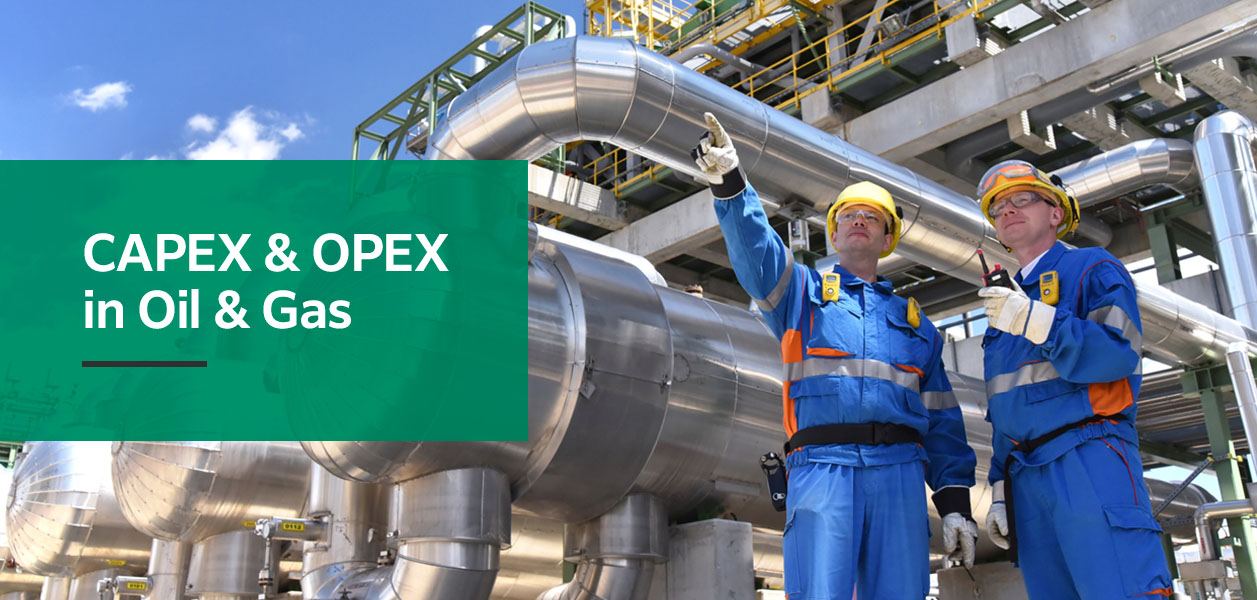
Jump to:
Running a company involves many types of expenses, most of which fall under one of two categories — capital expenditures (CAPEX) and operating expenditures (OPEX). Understanding these two values is crucial for any organization, especially in the oil and gas industry, where innovation, exploration and global volatility impact many aspects of the business.
A successful business has a healthy approach to CAPEX and OPEX, and reducing these costs can help you become more profitable and free up funds for growing the business. Let’s explore CAPEX and OPEX in the oil and gas industry and how you can reduce these costs.
What Is CAPEX?
CAPEX refers to capital expenditures, or the costs used for acquiring, upgrading or maintaining physical assets. These physical assets might include property, buildings, equipment, plants or technology. You could use CAPEX to repair an old facility, upgrade your IT hardware or buy a more advanced piece of equipment. Typically, CAPEX will help the business in the long-run, expanding capabilities or improving finances in the future.
CAPEX plays a large role in businesses focused on growth and new investments. These businesses likely spend significant amounts on CAPEX, which can support many long-term goals, such as expanding into new markets or boosting profits.
What Is OPEX?
Oil and gas OPEX refers to operating expenditures, or the day-to-day expenses incurred during business operations. Some examples of OPEX include:
- Rent, mortgage or utility costs
- Marketing
- Payroll and benefits administration
- Equipment maintenance
- Supplies and inventory
- Insurance
- Research and development
- Depreciation
A company’s OPEX depends on many factors, such as its size and goals. Other elements, like volatility in the labor field or supply chain challenges, can also increase OPEX. For example, a raw material shortage might drive up the cost of supplies and a product’s overall cost.
In the oil and gas industry, OPEX can heavily influence profit margins. As a global industry, it faces volatility from many angles, so keeping OPEX in check can be challenging but beneficial. Fortunately, OPEX involves many different costs, so you can use various strategies to reduce them.
CAPEX vs. OPEX
The meanings of CAPEX and OPEX point toward different purposes. While CAPEX facilitates long-term benefits through growth and investment, OPEX is an ongoing, unavoidable cost that keeps the business moving. From a tax perspective, a business can write off OPEX during the year they were incurred, while CAPEX must be capitalized or written off over time. Both will impact your financial statements and play a role in the decision-making process.
For example, if your OPEX is too high, you may not have many funds left for investing in new technology or upgrading your equipment. You spend a lot of money to keep the lights on but keep business growth stagnant. In the long-run, having outdated assets will drive up OPEX, further exacerbating the problem.
Alternatively, a more balanced budget would let you spend enough on OPEX to ensure successful operations and invest in CAPEX to lay the groundwork for valuable improvements later. OPEX affects your ability to invest in CAPEX and vice versa.
Finding the right balance is critical, and reducing costs in one area can help you save in another.

How to Reduce CAPEX and OPEX in Oil and Gas
These two expenditures are often intertwined, but it’s important to find CAPEX costs with high returns on investment (ROI) for OPEX. These investments have a limited impact on CAPEX while helping you reduce OPEX. Over time, this approach can help you increase profits and devote more resources toward your most pressing business goals.
Here are some strategies for reducing CAPEX and OPEX in oil and gas businesses.
1. Make Smart Investments in Technology
A great way to manage operational costs is to make CAPEX investments that directly reduce OPEX. Look for high-quality technology solutions that reduce costs in the long run. Consider your highest OPEX costs and how technology can mitigate them.
For example, you might consider CAPEX investments such as:
- Software or equipment that automates tasks and minimizes human involvement, reducing payroll costs.
- Smaller equipment or fewer instruments that take up less space and eventually reduce how much property you need.
- Technology that eliminates the need for some supplies, such as paper or processing solutions.
- Low-maintenance equipment that can help you avoid frequent maintenance costs.
- Eco-friendly technology that can reduce utility usage and bills.
If you work with gas treatment, for example, switching to a gas membrane system can help you meet all of these goals. Amine gas treatment is a common alternative technique, but it has high OPEX costs and requires large equipment, regular solution replenishment, waste removal and frequent maintenance.
Gas membrane systems are much smaller and simpler, requiring less space and less maintenance. They don’t use hazardous chemicals that require labor-intensive replenishment and disposal, and they have the bonus of being more environmentally friendly. Gas membranes can even reduce the OPEX of amine systems when used as an adjunct technology.
Look for CAPEX opportunities with high ROIs, such as gas membrane systems, to help reduce your OPEX.
2. Improve Negotiations
Many CAPEX and OPEX purchases start with negotiations. Effective bargaining can help you get better deals and save on both kinds of expenses. To improve negotiations, consider ramping up training for your buyers and compiling strong performance metrics that illustrate your position as a good business partner.
Say you’re negotiating insurance for the company. If you collect data on safety incidents and have very few accidents, your “good behavior” can help the insurance provider see that you’re a low risk and convince them to lower costs, reducing your OPEX. Safer equipment — such as gas separation membranes with limited labor requirements and no hazardous chemicals — can also help improve your metrics and, ultimately, your negotiated rates.
3. Use Eco-Friendly Practices
You can reduce some OPEX costs with small changes to promote eco-friendly practices. For instance, moving from paper-based processes to electronic ones can help you save on the costs of printers, paper and ink. Using fewer harmful chemicals in your processes can reduce emissions and the costs associated with capturing them or being carbon neutral. Many eco-friendly upgrades come with OPEX benefits, too.
Consider where your OPEX is coming from and whether a move to eco-friendly alternatives could help you save.

Save On CAPEX and OPEX With Fujifilm
Both CAPEX and OPEX play a crucial role in oil and gas organizations. Finding the right balance calls for capable technology with a high ROI. Our natural gas separation membranes allow you to significantly reduce the OPEX costs of gas purification with an affordable CAPEX investment. These simple but sophisticated gas membranes are compact, inexpensive to operate, low-maintenance, long-lasting and chemical-free.
Reach out to us today to learn more about our gas separation membranes and see how they can reduce your CAPEX and OPEX costs.













